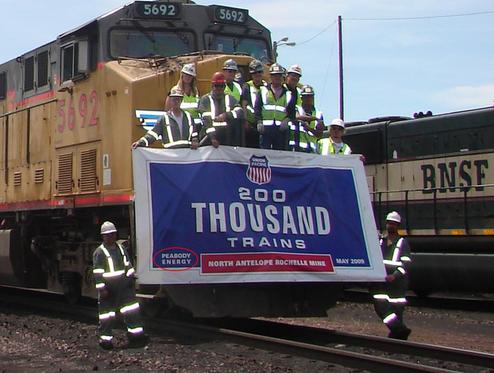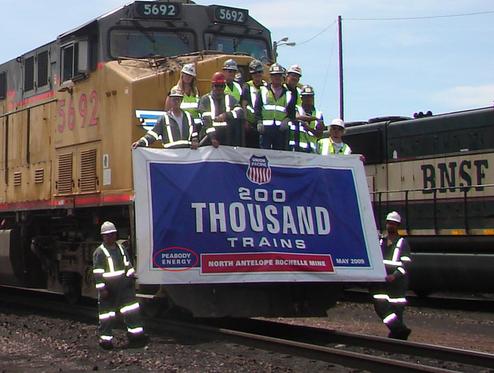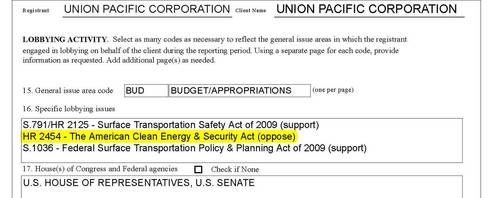Why is the U.S. Chamber of Commerce on such a different page from its major members when it comes to climate change legislation?
Last spring we raised the question of who the U.S. Chamber of Commerce is really representing when it comes to the issue of climate change. It seemed curious that although 19 of the companies on the Chamber’s board were on-record supporting climate legislation while only four (including three coal companies) were against it, the U.S. Chamber staff continued to take a hard-line position on the issue. And as I’ve previously discussed, the U.S. Chamber announced in June 2009 that it would spend $100 million fighting proposals it opposes, including on climate policy.
Now, a new question has arisen, prompted by this 2006 item about the 25th anniversary of a railroad line built by Union Pacific railroad to carry coal from southern Wyoming to the rest of the U.S.
What is the connection between Union Pacific Railroad, dirty coal and the U.S. Chamber? The dots connecting them draw what has the appearance of a conflict of interest between Tom Donohue’s role as President of the U.S. Chamber of Commerce and his role as an 11-year member of the Union Pacific Railroad’s Board of Directors.
Starting with Mr. Donohue: U.S. Chamber President Tom Donohue has been on the board of directors at Union Pacific since 1998. As a Union Pacific board member, Donohue has been well cared for.
- He has been paid annual retainers by Union Pacific amounting to at least $1,134,333 since 1998.
- As of 2008, Donohue has been granted over 43,000 shares of Union Pacific stock, and is entitled to the value of nearly 20,000 more shares when he leaves the board — a package whose combined value would be over $3.8 million if he were to sell it today.
- So being on the Union Pacific board can be seen as worth about $5 million to Tom Donohue, so far. (You can piece all this compensation together from the company’s proxy statements.)
In addition, Union Pacific has been good to the U.S. Chamber:
- Union Pacific has given $700,000 to the U.S. Chamber since 2004, including $500,000 to the Chamber’s “Leadership Fund” (a common name for PACs run by Chambers of Commerce), $100,000 to a voter education project in 2006 and $100,000 to an award ceremony in 2007. (These contributions to the Chamber are reported in the company’s 2009, 2008 and 2007 proxy statements.)
Ok, but it is common for people in Donohue’s position to be on various boards and such. So what? Well, I don’t know what the U.S. Chamber’s policy on conflict of interest says, but if it doesn’t cover this situation, it needs fixing.
Union Pacific has a vested interest in making sure it can continue to haul lots of coal.
- Union Pacific is big in the business of carrying coal from mines to power plants, including from the Powder River Basin in Wyoming, the source of about 38 percent of all the coal produced in the U.S.
- Coal shipments are estimated to make up about 20 percent of freight revenues enjoyed by the big rail carriers, including Union Pacific.
-
“We may be affected by climate change and market or regulatory responses to climate change…restrictions, caps, taxes, or other controls on emissions of greenhouse gasses, including diesel exhaust, could significantly increase our operating costs …[and] could also affect our customers … [which could] reduce the amount of traffic we handle and have a material adverse effect on our results of operations, financial condition, and liquidity.”
- Which explains why Union Pacific has spent over $3 million on lobbying activities so far this year, including efforts to oppose the American Clean Energy and Security Act.
- Not surprisingly, Union Pacific is a member of the beleaguered coal coalition known as ACCCE, which is hemorrhaging members opposed to its extremist agenda on climate change legislation.
Clearly, Union Pacific is worried about what climate legislation would do to its business, and decided to oppose the climate bill that the U.S. House passed in June.
It’s easy to understand Union Pacific’s interest in maintaining its lucrative coal traffic. Union Pacific and BNSF, another giant railroad (and ACCCE member!) have invested hundreds of millions over the last 25 years in a joint rail line capable of moving the coal.
It’s a big deal to these companies — they even issued a press release celebrating the 200,000th rail car of coal being shipped out of the Basin, an event memorialized in this group picture – which happens to show that the coal being shipped in the 200,000th train came from a coal mine owned by Peabody Energy (another ACCCE member! and one of the four U.S. Chamber board members that opposes climate policy.)

(Arch Coal and Western Fuels Association — both ACCCE members! — didn’t make the picture I guess, even though they also have coal mines in the same region and rely on Union Pacific to move their coal. In fact, every one of Arch Coal’s western mines rely on Union Pacific trains.)
So to review…The President of the U.S. Chamber of Commerce, who is resisting calls from his own board members to stop fighting against federal climate policy, is being richly compensated by Union Pacific, a company which — along with some of its key businesses partners — is vigorously fighting against federal climate policy.
This isn’t actually the first time that Mr. Donohue’s potential conflicts of interest have come up. In 2005, the New York Times reported on concerns about Mr. Donohue’s roles on corporate boards, though at the time climate policy was not one of the issues mentioned.
So, it would seem fair for some of the companies on the Chamber board that want to move forward — Johnson & Johnson, Nike, PNM Resources, Dow, and recent ACCCE abandoners Duke and Alcoa — to wonder whether they are getting railroaded. And it would seem fair to ask Tom Donohue to explain how he’s going to address this apparent conflict of interest.
This post originally appeared on Pete’s Switchboard blog.





